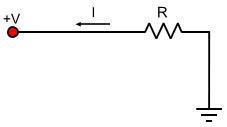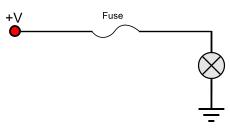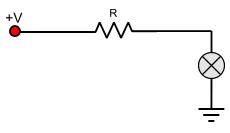
|
 Home Home
 Projects Projects
 Experiments Experiments
 Circuits Circuits
 Theory Theory
 BLOG BLOG
 PIC Tutorials PIC Tutorials
 Time for Science Time for Science
|
| ||
|
22 March 2009 Author: Giorgos Lazaridis Ohm's LawThe Ohm's law itself The current in a circuit is directly proportional to the voltage and reverse proportional to the resistance 
This is the most important law for electronics. What this phrase means is that for the previous circuit, if the power supply V is 1 Volt and the resistor is 1 Ohm, a current will flow within the circuit of 1 Ampere. In mathematical meanings this is: I=U / R By simply changing the solving element we have: R=U / I and U=R x I So simple, so helpful In the following circuit, suppose we have a power supply of 3 Volts and we want to light an LED. This LED needs about 30mA of current at 3 volts to light. So we need to calculate the protective resistor R to keep the current lower than 30 mA. Using the ohm's law we have: R=U/I => R=3/0.03=100 Ohms (30mA=0.03 Amperes) 
In the following circuit, there is a simple car light circuit with a power supply of 12 Volts and a headlight lamp. The internal 'hot' resistance of the lamp is 6 Ohms. We must calculate the protective fuse so that it allows the maximum current flow. Using the Ohm's law we have: I=U/R => I=12/6 = 2 Amperes. So we will use a fuse with bigger value than 2 amperes, something like 2.5 or 3 amperes. 
Taking it further The type for calculating the power is P=U x I. We can use the Ohm's law to change this type as follows: P=U x I (1) U= I x R (2) Solving (1) using (2) : P= I2 x R (3). Also: I=U/R (4) Solving (1) using (4) : P= U2 / R (5). Using types (3) and (5) we have a way to calculate power using the resistor. If for example we need to put a very small series resistor to a load like lamp to measure the current drawn from this lamp, we need to calculate the power of the resistor. In the following circuit, the resistor is 1 Ohm. It is there just to cause a slight voltage drop that can be measured. This measurement can be transformed (using Ohm's law again) into current. If for example the voltage drop on the resistor is 1.5 volt, the amperage of the lamp is I=U/R => I=1.5 Amperes. 
But as we know, resistors can only handle up to a predefined amount of power. More power could destroy them. To calculate this amount of power we need to know what is the maximum current that will be drawn from the source in any case. For the lamp we can say that 2 amperes are far enough. The power of the resistor should be: P=I2 x R = 4 x 1 => P = 4 watts. Relative pages Comments
|
|
 Contact Contact
 Forum Forum
 Projects Projects
 Experiments Experiments
 Circuits Circuits
 Theory Theory
 BLOG BLOG
 PIC Tutorials PIC Tutorials
 Time for Science Time for Science
 RSS RSS
Site design: Giorgos Lazaridis © Copyright 2008 Please read the Terms of services and the Privacy policy |